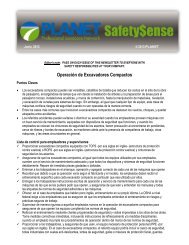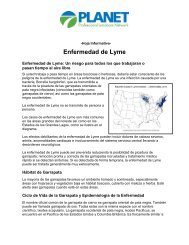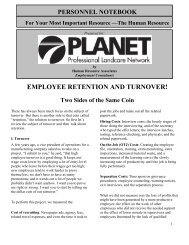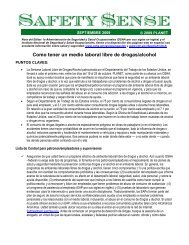Economic Impacts of the Green Industry in the - Urban Forest ...
Economic Impacts of the Green Industry in the - Urban Forest ...
Economic Impacts of the Green Industry in the - Urban Forest ...
Create successful ePaper yourself
Turn your PDF publications into a flip-book with our unique Google optimized e-Paper software.
In contrast, <strong>the</strong> focus on mass marketers by large growers has created opportunities for smaller growers to<br />
develop niches serv<strong>in</strong>g <strong>in</strong>dependent retailers or to go <strong>in</strong>to retail<strong>in</strong>g <strong>the</strong>mselves, sell<strong>in</strong>g directly to <strong>the</strong> consumer. In<br />
a recent survey <strong>of</strong> growers, it was found that <strong>the</strong> majority <strong>of</strong> several thousand producers surveyed did some<br />
retail<strong>in</strong>g <strong>of</strong> <strong>the</strong>ir own, whe<strong>the</strong>r that was 1 percent or 100 percent <strong>of</strong> <strong>the</strong>ir production. Smaller growers appeared to<br />
sell higher percentages, on average, <strong>of</strong> <strong>the</strong>ir production at retail. Yet, some larger producers have also used <strong>the</strong>ir<br />
own retail sales as a tactic for diversification. In many <strong>in</strong>stances, producers <strong>in</strong> <strong>the</strong> middle seemed to focus <strong>the</strong>ir<br />
production on sell<strong>in</strong>g to <strong>in</strong>dependent retailers, perhaps <strong>in</strong>clud<strong>in</strong>g a retail operation <strong>of</strong> <strong>the</strong>ir own.<br />
The o<strong>the</strong>r impact <strong>of</strong> mass marketers on <strong>the</strong> <strong>in</strong>dustry has been one <strong>of</strong> consolidation. In recent years, grower<br />
numbers have appeared to decl<strong>in</strong>e from year to year, or at best, rema<strong>in</strong> stable. One could debate why <strong>the</strong> producer<br />
numbers are dim<strong>in</strong>ish<strong>in</strong>g, but many would argue that <strong>the</strong> stresses <strong>of</strong> ei<strong>the</strong>r supply<strong>in</strong>g mass marketers or compet<strong>in</strong>g<br />
with <strong>the</strong>m as an <strong>in</strong>dependent grower-retailer are tak<strong>in</strong>g <strong>the</strong>ir toll. The capitalization requirements, <strong>the</strong> reduced<br />
marg<strong>in</strong>s, <strong>the</strong> <strong>in</strong>creased demands, <strong>the</strong> risk associated with fewer customer numbers, and <strong>the</strong> result<strong>in</strong>g consequences<br />
should that risk come to be realized have all created market pressures for larger producers. The struggle to rema<strong>in</strong><br />
competitive <strong>in</strong> a viable niche for smaller producers can be equally try<strong>in</strong>g <strong>in</strong> markets be<strong>in</strong>g <strong>in</strong>undated by<br />
compet<strong>in</strong>g cha<strong>in</strong>s. There are already certa<strong>in</strong> markets where <strong>in</strong>dependents can hardly be found.<br />
Previous <strong>Economic</strong> Impact Studies<br />
In spite <strong>of</strong> <strong>the</strong> magnitude and recent growth <strong>of</strong> <strong>the</strong> <strong>Green</strong> <strong>Industry</strong> outl<strong>in</strong>ed above, <strong>the</strong>re is surpris<strong>in</strong>gly little<br />
<strong>in</strong>formation that has been developed at <strong>the</strong> national level regard<strong>in</strong>g <strong>the</strong> economic impact <strong>of</strong> <strong>the</strong> <strong>Green</strong> <strong>Industry</strong>.<br />
The USDA does conduct floriculture and nursery crop surveys to collect <strong>in</strong>formation at <strong>the</strong> grower level, but<br />
<strong>the</strong>se data are <strong>of</strong>ten <strong>in</strong>complete for some states and <strong>the</strong> cash receipts reported for/by growers do not reflect <strong>the</strong><br />
fur<strong>the</strong>r economic impacts generated from this production activity. Census data, <strong>in</strong>clud<strong>in</strong>g <strong>the</strong> 10-year Census <strong>of</strong><br />
Horticultural Specialties, is subject to <strong>the</strong> same limitations and has historically had o<strong>the</strong>r mitigat<strong>in</strong>g problems<br />
such as poor response rate, which reflects poorly on <strong>the</strong> data’s accuracy. For firms downstream <strong>in</strong> <strong>the</strong> supply<br />
cha<strong>in</strong>, such as landscapers, re-wholesalers, and retailers, <strong>the</strong>re is Standard Industrial Classification (SIC) data<br />
ma<strong>in</strong>ta<strong>in</strong>ed by each state’s Office <strong>of</strong> <strong>the</strong> Comptroller, but misclassification errors and non-compliance on <strong>the</strong> part<br />
<strong>of</strong> <strong>in</strong>dustry participants have made some state’s data speculative at best. There is a new sector<strong>in</strong>g scheme called<br />
<strong>the</strong> North American Industrial Classification System, or NAICS for short, which should provide more robust<br />
estimates <strong>in</strong> <strong>the</strong> future. However, to date, no one source <strong>of</strong> data has proven to be adequate <strong>in</strong> captur<strong>in</strong>g <strong>the</strong> total<br />
economic importance <strong>of</strong> <strong>the</strong> <strong>Green</strong> <strong>Industry</strong>.<br />
Recogniz<strong>in</strong>g <strong>the</strong> limitations <strong>of</strong> exist<strong>in</strong>g data sources and also <strong>the</strong> critical need for this type <strong>of</strong> economic impact<br />
data, several state nursery and landscape associations have sponsored and developed <strong>the</strong>ir own economic impact<br />
studies for <strong>the</strong>ir respective green <strong>in</strong>dustries. Such associations have found <strong>the</strong>se studies to be useful <strong>in</strong><br />
communicat<strong>in</strong>g <strong>the</strong> importance <strong>of</strong> <strong>the</strong> <strong>Green</strong> <strong>Industry</strong> to state legislatures, <strong>in</strong> ga<strong>in</strong><strong>in</strong>g assistance and resources, and<br />
<strong>in</strong> combat<strong>in</strong>g proposed legislation that would have had negative impacts on urban or community forestry<br />
<strong>in</strong>itiatives and <strong>the</strong> <strong>Green</strong> <strong>Industry</strong>. As useful as <strong>the</strong>se state-specific studies have been, <strong>the</strong>re have not been<br />
comparable analyses conducted at <strong>the</strong> national level that would provide similar benefits on that scale.<br />
Additionally, each <strong>of</strong> <strong>the</strong> researchers conduct<strong>in</strong>g state-level studies used different research methodologies <strong>in</strong> <strong>the</strong>ir<br />
respective analyses, which were completed <strong>in</strong> different time frames. Thus <strong>the</strong> cross-sectional and time-series<br />
comparability <strong>of</strong> such studies is quite limited. None<strong>the</strong>less, this chapter attempts to summarize <strong>the</strong> f<strong>in</strong>d<strong>in</strong>gs <strong>of</strong><br />
previous studies so that a common “po<strong>in</strong>t <strong>of</strong> departure” can be used as a benchmark from which to compare <strong>the</strong><br />
results from this study which is national <strong>in</strong> scope.<br />
Table 1-2 presents an overview <strong>of</strong> previous economic impact studies that have been conducted [<strong>in</strong> <strong>the</strong> last five<br />
years] regard<strong>in</strong>g <strong>the</strong> <strong>Green</strong> <strong>Industry</strong> <strong>in</strong> selected states. While <strong>the</strong>re have been o<strong>the</strong>r studies conducted (mostly by<br />
<strong>the</strong> Agricultural Statistics Service <strong>in</strong> respective states) that estimate grower-level sales or cash receipts, this<br />
summary only presents those that provide subsequent post-farm gate economic impacts. There have been o<strong>the</strong>r<br />
economic impact studies conducted <strong>in</strong> some states regard<strong>in</strong>g turfgrass-related economic impacts (Table 1-3), but<br />
<strong>the</strong> focus here is on <strong>the</strong> economic impacts <strong>of</strong> <strong>the</strong> entire <strong>Green</strong> <strong>Industry</strong>. In Table 1-2, <strong>the</strong> studies are listed by state<br />
<strong>in</strong> alphabetical order. Total <strong>Green</strong> <strong>Industry</strong> sales are presented, along with <strong>the</strong> total employment and payroll<br />
associated with <strong>Green</strong> <strong>Industry</strong> sectors. Some state studies also provided estimates <strong>of</strong> value added and taxes paid<br />
17
















